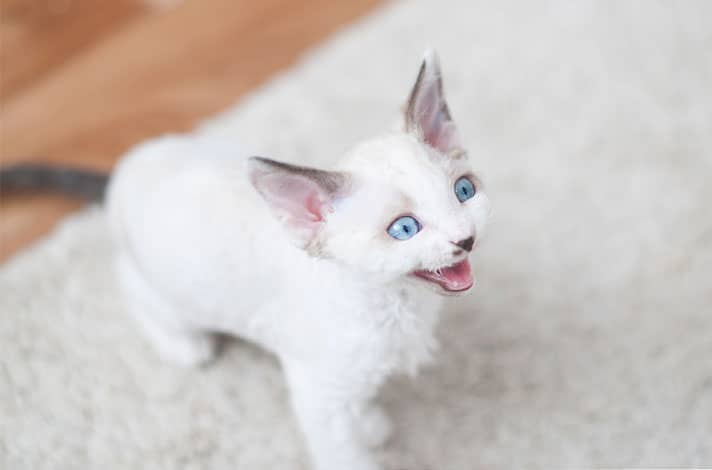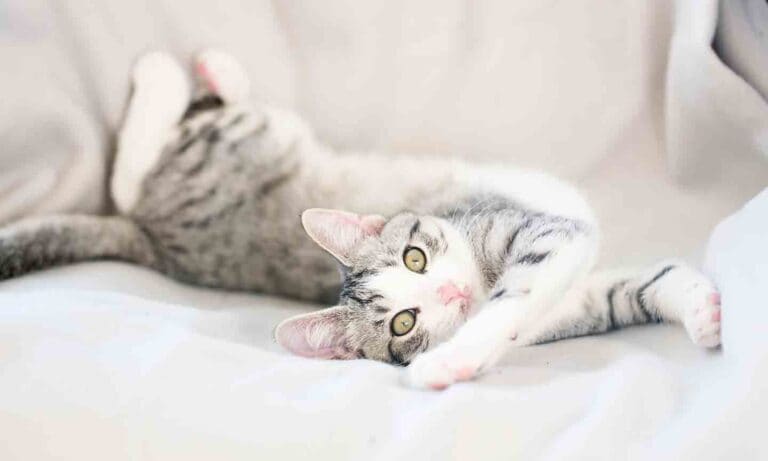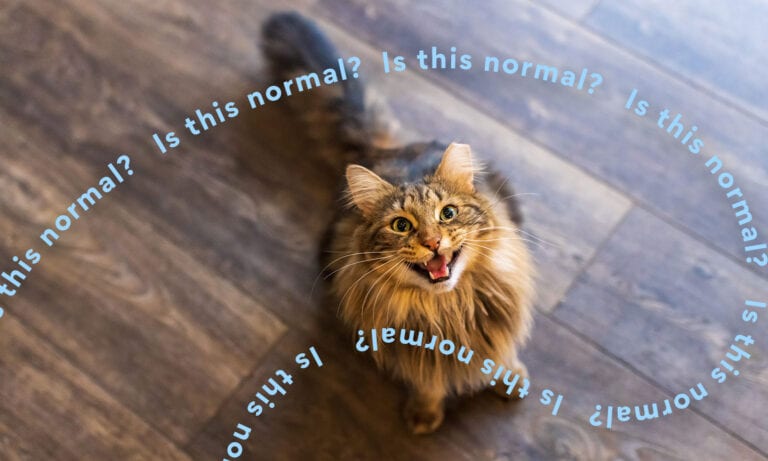Can cats cry? Yes. In fact, common questions from cat parents are: “Why do cats cry?” and “How do I stop my cat’s meowing?”
The reasons behind a crying cat go beyond wanting cat food. Vocalization, and especially meowing, is aimed at humans. Cats are smart and understand that people communicate primarily with sounds, so they give us what we want.
Cats cry for several reasons, and the sound varies between breeds, ages and even personality. But all cats use meows as demands, and they’re most often aimed at humans.
7 Meow-Demands: Why Do Cats Cry
1. Your cat wants cat food.
Cats develop internal clocks and know exactly when mealtime rolls around. Meow-demands come fast and furious when the bowl empties and tummies rumble. Get your cat on a schedule and try not to vary times or your cat will try to turn you into a treat machine.
2. Your cat wants out.
Cats think they’re always on the wrong side of the door. They often use meow-demands to get humans to play doorman. Pet doors provide access to cat-safe rooms or cat outdoor catios.
3. Your cat wants attention.
Cats are quite social with people they love and easily grow bored. When paw-pats fail, cats resort to crying to get petting and play. Be sure to reciprocate and offer attention on a schedule as ignoring feline overtures will get you snubbed later when you want to interact.
4. Your cat is annoyed with you.
Forcing a cat to do anything he dislikes may prompt caterwauling. For example, cats often meow for release when held too long for their liking. Watch body language and stop what you’re doing before the ears turn sideways and the tail thumps a warning, or meows could turn to bites.
5. Your cat is scared.
A frightened cat may start out with protest meows, but more often fear turns cries into hisses and growls. A truly frightened cat hides and falls silent, not wanting to draw attention to himself.
Figure out what’s scary and help relieve kitty angst. Pheromone products like Feliway’s plug-in may help.
6. Your cat doesn’t feel well.
Sick cats try to hide illness, but there are exceptions. Some cry prior to vomiting or coughing up a hairball.
Hypertension, cognitive issues of aging cats, and deaf cats often meow a great deal from discomfort, confusion or anxiety. Any time meows increase from the norm should signal a veterinary checkup.
7. Your cat is simply chatty.
Oriental-type breeds—Siamese, Bengal, Tonkinese and Sphynx—talk a great deal. Talking back to these cats encourages the behavior.
Types of Cats Meowing
In most cases, adult cats only meow at humans, but there are exceptions. After all, cats don’t follow a rule book and are experts at making up their own rules. So, how do you know why your cat is meowing? Here are some common types of cat meows:
Polite request: Cat meows begin as polite requests in a moderate tone—short and sweet.
Expressions of delight: May be mixed with trills and chirps.
Ignored meow-demands: Lower pitched, longer held and more strident.
Stress-meows: Shorter and more repetitive. However, stress more often tends to change behavior. For example, a usually quiet cat may turn up the meows during a car ride, and a normally vocal chatty kitty may fall silent at the vet.
How to Decode a Crying Cat
Unfortunately, humans are notoriously bad at interpreting cat messages from the sound alone. To decipher what your crying cat is trying to say when he’s meowing, pay extra attention to what he’s doing when he talks throughout the day.
Cats are creatures of habit, and crying at the same time or place usually means the same thing, so you can anticipate what he wants. For instance, crying at 5:30 p.m. each day may mean he’s hungry—and when you feed him in response, you’ve rewarded the behavior so he’s more likely to meow every day at 5:30 p.m.
Also understand that though a crying cat uses meowing to communicate, more often cats “talk” with their whole body. To understand your crying cat, check out what the rest of his body says, too.
Listen and watch your cat when:
- You make his cat food and briefly withhold it. A hungry cat becomes impatient and his meows become plaintive to demand that you hurry up and fill the bowl.
- Your cat gets tired of being petted. These meows grow in intensity and become strident or even mix with growls, and indicate potential aggression. When he becomes over-stimulated, he’s likely to bite or swat if these meows are ignored and you keep on petting him.
- Your cat wants access to a blocked-off room. Cats often meow at closed doors to tell you they want in, or they want out. The longer you ignore their cries, the lower-pitched and more demanding they become.
- Your cat rubs against your leg. Meows during this action can mean he wants some attention like petting or playtime.
- Your cat is traveling in the car. Meows during this time usually indicates kitty distress or even fear.
- Your cat is in the vet’s waiting room. Crying at the vets is common with cats and mean everything from the cat hating his carrier and wanting out, to being scared of the strange sounds and smells at the vet.
Once you’ve become familiar with your individual cat’s meow repertoire, you can better address your cat’s needs. Remember that giving in to meow-demands makes him more likely to repeat the behavior. So, if Kitty wakes you at 3 a.m. with a “feed me” meow, or wants to play and be petted, be careful about giving in. That trains him to wake you every morning at 3 a.m.
Recognizing your cat’s “leave me alone” meow when he’s had enough petting can alert you to other situations of potential aggression. For instance, he may not appreciate a visiting toddler’s attention, so make sure child and cat are out of paw-swipe range when these meows erupt.
Distress and fear meows you hear during car rides or at the vet might also sound when Kitty encounters scary situations. A new cat in the house, or a stray dog visiting the yard, and even a strange smell on you (did you hug your new date?) could prompt fearful meows. Cats take lots of time to accept new situations, so make cat carriers, vet visits and stranger encounters less stressful by planning ahead with proper introductions.
How to Stop Cats Meowing
Much of the meow-habit depends on what kitty achieves with the vocalization. Are you rewarding the behavior?
My 5-year-old cat Karma meows at the new puppy when the big dog “looms” over him. This is a demand to back off. It also prompts humans to intervene, which rewards the behavior.
Karma also meows during litter box excavations. That alerts me to scoop, again a reward.
Cats meowing won’t stop by themselves, and most of it is a normal part of being a feline. Meowing becomes obnoxious late at night and early in the morning when cats demand attention or cat food at inappropriate or inconvenient times. The meow-demands, when ignored, escalate to paw-pats on your face or even love-nips to get you out of bed.
You can stop pester-meowing, but it’s not easy and requires “tough kitty love.”
Blame yourself, first, for rewarding the behavior. Each time you give in to the meow-demands late at night to fill the bowl or even toss a pillow, the cat wins with cat food and attention.
The ONLY way to stop the crying cat is to stop rewarding the behavior by ignoring him.
Feed and play with your cat on a schedule. Offer him a cat puzzle toy like PetMate’s FunKitty fishbowl for late-night snacking. When you sleep, close your cat out of the bedroom. Invest in ear plugs. Remember, talking back to him or giving in to his demands just encourages the behavior.
Also, be aware that an “extinction burst” in behavior terms means the meowing gets worse before it goes away. That’s when most folks give up and give in—so be strong and stay the course. When the cat crying gets worse, that means the pester-meows will soon start to fade away.

Amy Shojai, CABC,(www.SHOJAI.com) is a certified animal behavior consultant for cats and dogs, and the author of more than 30 award-winning pet care books. She lives in North Texas with a smart-aleck Karma-Kat, and fun-loving bullmastiff Bravo.
Featured Image: via alien185/Thinkstock
Share:











